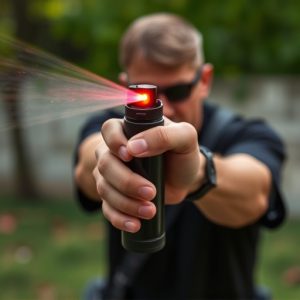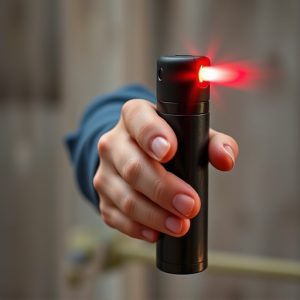Pepper Spray Potency: Navigating Legal Limits in Law Enforcement
Riot control agents like pepper spray are critical tools for police managing public disturbances, wi…….
Riot control agents like pepper spray are critical tools for police managing public disturbances, with legal regulation focusing on Pepper Spray Potency by Brand. This ensures effectiveness and prevents misuse through strict labeling, packaging, training, testing, and certification standards. With varying capsaicin concentrations and improved spray patterns, evaluating potency by brand is crucial for strategic crowd control. Law enforcement follows strict guidelines to avoid abuse, guided by international regulations and best practices that emphasize proportionality, necessity, and minimal force. Agencies adopt strategies including proper application training and using agents with proven safety profiles to protect officers and civilians while promoting responsible Pepper Spray Potency by Brand use.
Riot control agents, such as pepper spray, play a significant role in law enforcement tactics worldwide. This article delves into the legal perspective of these powerful tools, focusing on pepper spray as the most commonly used among them. We explore the varying potency levels of different brands and analyze their deployment strategies within legal boundaries. Additionally, international regulations and best practices for responsible use are examined, shedding light on the delicate balance between public safety and civil liberties.
- Understanding Riot Control Agents: A Legal Perspective
- Pepper Spray: The Most Common Riot Control Agent
- Analyzing Pepper Spray Potency by Brand
- Deployment Strategies and Legal Limitations of Riot Control Agents
- International Regulations and Best Practices for Law Enforcement Use
Understanding Riot Control Agents: A Legal Perspective
Riot control agents, also known as less-lethal weapons, are a crucial tool for law enforcement agencies in managing public disturbances and ensuring officer safety. These agents, including pepper spray, work by irritating the eyes, nose, and respiratory system, temporarily disabling individuals without causing permanent harm. The legal perspective on riot control agents is multifaceted, with regulations varying across jurisdictions. One critical aspect is the regulation of pepper spray potency by brand, ensuring that its effectiveness aligns with safety standards to prevent excessive force or misuse.
Legal frameworks often mandate specific requirements for the labeling and packaging of these agents, as well as training protocols for officers to ensure responsible deployment. The focus on pepper spray potency by brand underscores the need for transparency and accountability in law enforcement practices. This includes regular testing and certification to guarantee that each brand’s product meets established safety and efficacy standards. Such measures not only protect citizens but also promote public trust in law enforcement agencies’ handling of crowd control situations.
Pepper Spray: The Most Common Riot Control Agent
Pepper spray is often considered the go-to riot control agent due to its non-lethal nature and effectiveness in incapacitating individuals without causing permanent harm. It works by causing a burning sensation, constricting the eyes, and making it difficult to breathe, leading to temporary disorientation and immobilization. The most common active ingredient in pepper spray is capsaicin, which is derived from chili peppers.
When comparing pepper spray potency by brand, factors like concentration (typically measured in percent capsaicin), spray pattern, and range play significant roles in its effectiveness. Premium brands often offer higher concentrations, ensuring a more powerful punch. Moreover, advancements in technology have led to improved spray patterns that allow for better coverage of the target area, enhancing the agent’s overall efficiency.
Analyzing Pepper Spray Potency by Brand
When assessing riot control agents, particularly pepper spray potency by brand, it’s crucial to understand that not all sprays are created equal. Each manufacturer formulates their product with variations in capsaicin concentration, which directly impacts effectiveness and safety. Therefore, comparing pepper spray potency by brand becomes essential for law enforcement agencies aiming to equip officers with the most appropriate tools for crowd control scenarios.
Consistently evaluating brand formulations allows for informed decisions based on documented performance. Studies and user feedback can reveal differences in pain induction levels, fogging capabilities, and duration of effectiveness between brands. This knowledge ensures that riot control agents are deployed strategically, balancing the need to de-escalate situations with potential risks associated with over- or under-potency.
Deployment Strategies and Legal Limitations of Riot Control Agents
Law enforcement agencies employ various deployment strategies for riot control agents, each with its own set of legal limitations. One common method is the use of pepper spray, which works by irritating the eyes and respiratory system. The potency of pepper spray can vary significantly between brands, with some formulations offering more potent effects than others. However, its use is subject to strict guidelines and legal oversight.
Agencies must balance public safety with the potential for abuse or excessive force. In many jurisdictions, officers are required to exhaust non-lethal means before deploying riot control agents, such as warning shots or batons. The legal limitations also include restrictions on the types of agents that can be used based on factors like crowd behavior and environmental conditions. Failure to adhere to these guidelines can lead to civil rights violations and legal repercussions for law enforcement.
International Regulations and Best Practices for Law Enforcement Use
International regulations and best practices play a crucial role in guiding law enforcement agencies’ use of riot control agents, ensuring public safety and accountability. Organizations like the United Nations and various international human rights bodies have established guidelines that emphasize proportionality, necessity, and minimal force. These standards are designed to protect individuals from excessive or arbitrary use of force during civil disturbances or crowd control situations.
When it comes to specific agents, such as pepper spray, there is a growing emphasis on considering Pepper Spray Potency by Brand. Different manufacturers produce varying levels of capsaicin, the active ingredient, leading to differing potencies and effectiveness. Law enforcement agencies are increasingly adopting strategies that involve training officers in proper application techniques, conducting regular fitness testing, and utilizing agents with well-documented safety profiles. This approach not only ensures the safety of both officers and civilians but also promotes the effective and responsible use of riot control measures.
In conclusion, while riot control agents like pepper spray have proven valuable in law enforcement, their deployment must be carefully considered and regulated. Understanding the potency of different brands and adhering to international regulations is crucial to ensuring their responsible use. As practices evolve, ongoing research and dialogue between manufacturers, law enforcement agencies, and legal experts are essential to maintaining a balance between public safety and respect for individual rights. By examining the current landscape of riot control agents, from brand-specific potency to deployment strategies, we can foster best practices that uphold justice while minimizing harm.


